Today’s second estimate of U.S. GDP for the fourth quarter of 2012 showed growth moving from the -0.1 percent of the preliminary estimate to +0.1. Positive is better than negative, but a look at the details shows that the recovery is extremely weak. The following table shows how much each of the economy’s main sectors contributed to GDP growth in Q4.
Consumption, which has been the main driver of growth throughout the recovery, contributed slightly less in Q4 than previously reported. The categories housing and utilities, gasoline and other energy goods, and clothing and footwear all experienced absolute declines. These figures refer to real expenditures, so they reflect more than just the recent decreases in energy prices. The news is perhaps good for environmentalists, who will be glad to see a continuation of the gradual trend toward lower energy-intensity of GDP. It is not so good for anyone who hopes for consumer-led growth to reduce the stubbornly high unemployment rate.
The investment component of GDP presented a mixed picture in Q4. The revised figure for fixed investment was actually a little stronger than previously reported, led by purchases of equipment and software. However, that was more than offset by a downward revision of inventory investment. Farm inventories gained slightly, but there was a -1.7 percentage point contribution from nonfarm inventories. One way to interpret falling inventories is that already in the fourth quarter, businesses were becoming pessimistic about the likelihood of increased fiscal drag in 2013, and were, accordingly, selling off goods from their warehouses without restocking.
Speaking of fiscal drag, the government sector shrank even faster in Q4 than previously reported. As the following chart shows, both the federal and the state and local components of government purchases resumed their long string of negative contributions, after having briefly turned positive in Q3. Cuts in federal defense spending, which are likely to accelerate in 2013, were the biggest factor. The chart shows government consumption expenditures and gross investment. It does not include interest payments, entitlements, and other transfer payments, which are not GDP components.
The closest thing to a bright spot in today’s GDP numbers was a reversal of the net exports component. In the advance estimate, net exports contributed -.25 percentage points to growth. In the second estimate, that became +.24 percentage points. However, when we look at exports and imports separately, the news is still not good.
As the next chart shows, exports had contributed positively to GDP growth for fourteen straight quarters, from Q2 2009 through Q3 2012. The negative contribution for Q4, although slightly less than previously reported, is still disappointing.
The slower decline in exports accounted for only half of the turnaround in the external component of GDP. The rest came from an acceleration in the rate of decrease of imports from the .56 percentage points of the advance estimate to the .79 percentage points reported in today’s data release. To see why that is not unalloyed good news, it is important to understand how imports are treated in the GDP accounts.
In theory, GDP is the sum of consumption of domestically produced goods, investment expenditures on domestic goods, government purchases of domestic goods, and exports. In practice, however, the figures for consumption, investment, and government spending that are reported in the above tables and charts include spending on imported goods, for example, consumer purchases of imported clothing and business purchases of imported computers. To avoid double counting, government statisticians subtract total imports from the total of consumption, investment, government purchases.
Because imports enter the accounts with a negative sign, the positive contribution of imports to growth in the above table means a reduction in the volume of imports. That would be all well and good if it meant that domestic goods and services were becoming more competitive, so that consumers, businesses, and government were switching from imports goods to domestically produced equivalents. However, it is not such good news to the extent that consumers and others are cutting back on imports only because their spending as a whole is slowing.
The bottom line: We can welcome the turn from negative growth to positive in the latest report, but there is little to celebrate in the details. Politicians of both parties in Washington seem determined to subject the economy to a dose of euro-style fiscal austerity in 2013. The only disagreement is whether the austerity should consist entirely of spending cuts or should, instead, include some token revenue increase. Hopes for a fiscal grand bargain that would include pro-growth tax reform plus back-loaded deficit reduction have faded away. The recovery remains on life support, and it is unlikely that the third revision of Q4 GDP data, due a month from now, will change the picture very much.
Original post
- English (UK)
- English (India)
- English (Canada)
- English (Australia)
- English (South Africa)
- English (Philippines)
- English (Nigeria)
- Deutsch
- Español (España)
- Español (México)
- Français
- Italiano
- Nederlands
- Português (Portugal)
- Polski
- Português (Brasil)
- Русский
- Türkçe
- العربية
- Ελληνικά
- Svenska
- Suomi
- עברית
- 日本語
- 한국어
- 简体中文
- 繁體中文
- Bahasa Indonesia
- Bahasa Melayu
- ไทย
- Tiếng Việt
- हिंदी
Q4 GDP Moves From Negative To Positive: Recovery Still On Life Support
Published 03/01/2013, 01:46 AM
Updated 07/09/2023, 06:31 AM
Q4 GDP Moves From Negative To Positive: Recovery Still On Life Support
Latest comments
Loading next article…
Install Our App
Risk Disclosure: Trading in financial instruments and/or cryptocurrencies involves high risks including the risk of losing some, or all, of your investment amount, and may not be suitable for all investors. Prices of cryptocurrencies are extremely volatile and may be affected by external factors such as financial, regulatory or political events. Trading on margin increases the financial risks.
Before deciding to trade in financial instrument or cryptocurrencies you should be fully informed of the risks and costs associated with trading the financial markets, carefully consider your investment objectives, level of experience, and risk appetite, and seek professional advice where needed.
Fusion Media would like to remind you that the data contained in this website is not necessarily real-time nor accurate. The data and prices on the website are not necessarily provided by any market or exchange, but may be provided by market makers, and so prices may not be accurate and may differ from the actual price at any given market, meaning prices are indicative and not appropriate for trading purposes. Fusion Media and any provider of the data contained in this website will not accept liability for any loss or damage as a result of your trading, or your reliance on the information contained within this website.
It is prohibited to use, store, reproduce, display, modify, transmit or distribute the data contained in this website without the explicit prior written permission of Fusion Media and/or the data provider. All intellectual property rights are reserved by the providers and/or the exchange providing the data contained in this website.
Fusion Media may be compensated by the advertisers that appear on the website, based on your interaction with the advertisements or advertisers.
Before deciding to trade in financial instrument or cryptocurrencies you should be fully informed of the risks and costs associated with trading the financial markets, carefully consider your investment objectives, level of experience, and risk appetite, and seek professional advice where needed.
Fusion Media would like to remind you that the data contained in this website is not necessarily real-time nor accurate. The data and prices on the website are not necessarily provided by any market or exchange, but may be provided by market makers, and so prices may not be accurate and may differ from the actual price at any given market, meaning prices are indicative and not appropriate for trading purposes. Fusion Media and any provider of the data contained in this website will not accept liability for any loss or damage as a result of your trading, or your reliance on the information contained within this website.
It is prohibited to use, store, reproduce, display, modify, transmit or distribute the data contained in this website without the explicit prior written permission of Fusion Media and/or the data provider. All intellectual property rights are reserved by the providers and/or the exchange providing the data contained in this website.
Fusion Media may be compensated by the advertisers that appear on the website, based on your interaction with the advertisements or advertisers.
© 2007-2024 - Fusion Media Limited. All Rights Reserved.
